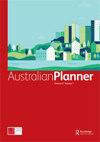A. J. Veal and Awais Piracha: meeting the need for a rational basis for open space and recreation planning in new high density residential areas: the Recreational Activity Benchmark model, Australian Planner , 2022. A rebuttal
IF 1.5
Q2 Social Sciences
引用次数: 0
Abstract
ABSTRACTVeal and Piracha propose an alternate approach to planning recreation provision in new high-density residential areas (NHDA’s) of Australian cities: the RAB or ‘Recreation Activity Benchmark’ (Veal and Piracha 2022). Sydney is used as a case study. This paper contends that the methodology has a range of substantive deficiencies and ignores other well-established planning approaches that have been developed, tested and refined through hundreds of plans prepared by in-house and consulting leisure planners over the past 50 years in Australia and detailed in a range of texts and planning manuals. In applying the Recreation Activities Benchmark (RAB), provision of physical leisure resources is made on the basis of ‘averaging’ the recreation activities that people pursue to determine what facilities they need in the wider city in which the NHDA occurs. The averages are then applied to a projected NHDA population. This review questions the lack of a philosophical and planning basis of the RAB; the need for the RAB methodology; what ‘average’ means in terms of recreation participation; how the average is ‘adjusted’ if sufficient space is not available; the fact that the average used in the methodology has been selected solely to avoid possible legal action by developers, and the fact that the RAB is no different to a provision ‘standard’, given the reliance on data that has inherent shortcomings. The rebuttal concludes by questioning the need for the methodology. Disclosure statementNo potential conflict of interest was reported by the author(s).Notes1 Senior officers from Inspiring Place report that the 2011 Huon Valley Open Space Strategy 2011–2021 was reviewed in the subsequent 2011 Recreation Plan. A further review was undertaken in the 2020 Huon Valley Recreation Plan. The latter report provides an assessment of what recommendations Council had implemented from the 2011–21 report. All reports show assessment of changing needs, policy and priorities based on research into demographics, existing provision, state and Council leisure policies and community and stakeholder engagement.a . J. Veal和Awais Piracha:满足新建高密度住宅区开放空间和休闲规划的合理基础需求:休闲活动基准模型,澳大利亚规划师,2022。反驳
Veal和Piracha提出了在澳大利亚城市新建高密度住宅区(NHDA)规划休闲设施的另一种方法:RAB或“休闲活动基准”(Veal和Piracha 2022)。悉尼被用作案例研究。本文认为,该方法存在一系列实质性缺陷,并忽略了其他成熟的规划方法,这些方法在过去50年里已经通过澳大利亚内部和咨询休闲规划师编制的数百个计划开发、测试和完善,并在一系列文本和规划手册中进行了详细说明。在应用休闲活动基准(RAB)时,在“平均”人们追求的休闲活动的基础上提供物理休闲资源,以确定在NHDA发生的更广泛的城市中他们需要什么设施。然后将平均值应用于预计的NHDA人口。这篇综述质疑RAB缺乏哲学和规划基础;对审核方法的需要;就娱乐参与而言,“平均”意味着什么;如果没有足够的舱位,海损如何“调整”;事实上,方法中使用的平均值只是为了避免开发人员可能采取的法律行动,而且考虑到对数据的依赖存在固有缺点,RAB与条款“标准”没有什么不同。反驳的结论是质疑这种方法的必要性。披露声明作者未报告潜在的利益冲突。注1 Inspiring Place的高级官员报告称,2011年休恩谷开放空间战略2011 - 2021已在随后的2011年娱乐计划中进行了审查。在2020年休恩河谷娱乐计划中进行了进一步的审查。后一份报告评估了理事会在2011-21年报告中实施了哪些建议。所有报告都显示了对不断变化的需求、政策和优先事项的评估,这些评估基于对人口统计、现有规定、州和理事会休闲政策以及社区和利益相关者参与的研究。
本文章由计算机程序翻译,如有差异,请以英文原文为准。
求助全文
约1分钟内获得全文
求助全文

 求助内容:
求助内容: 应助结果提醒方式:
应助结果提醒方式:


